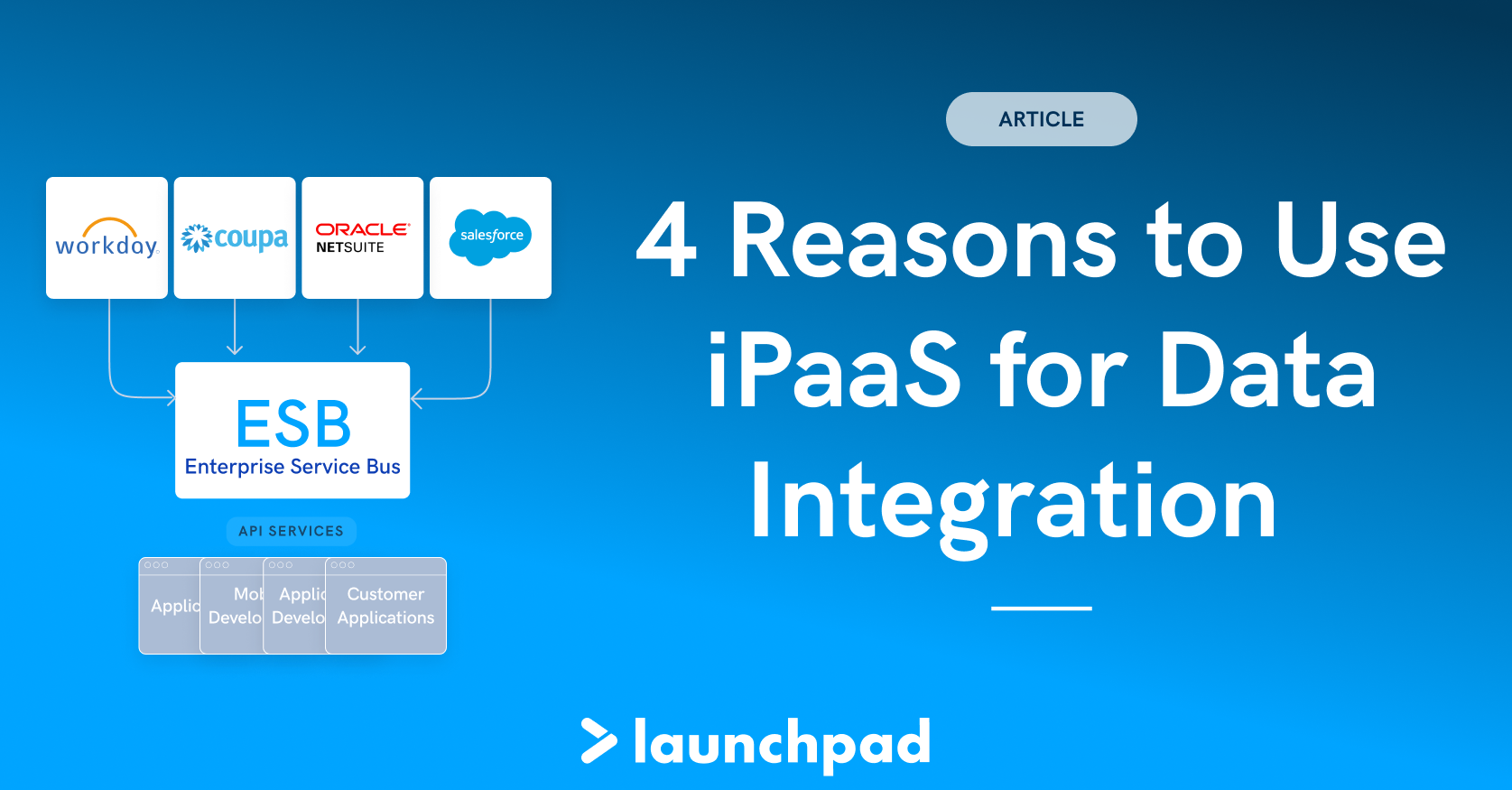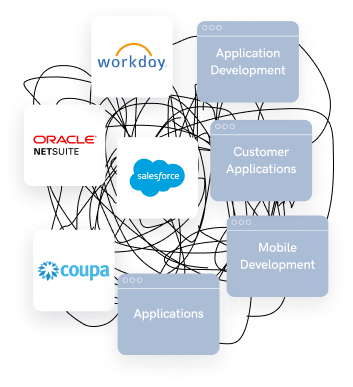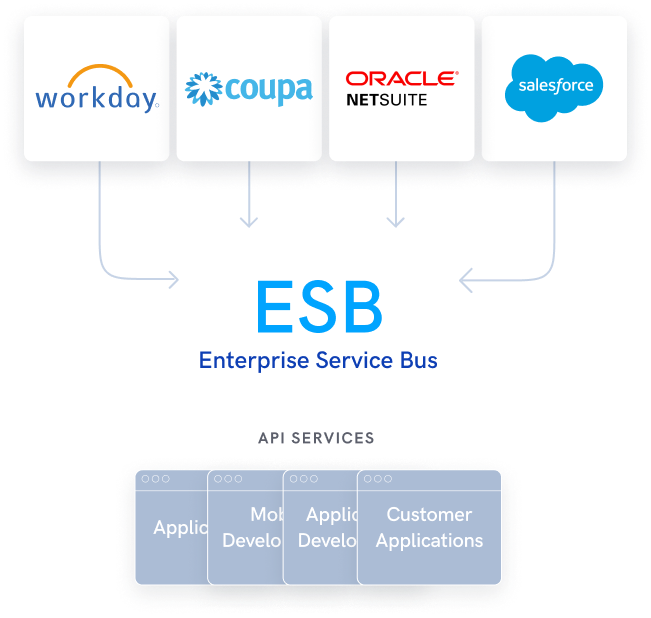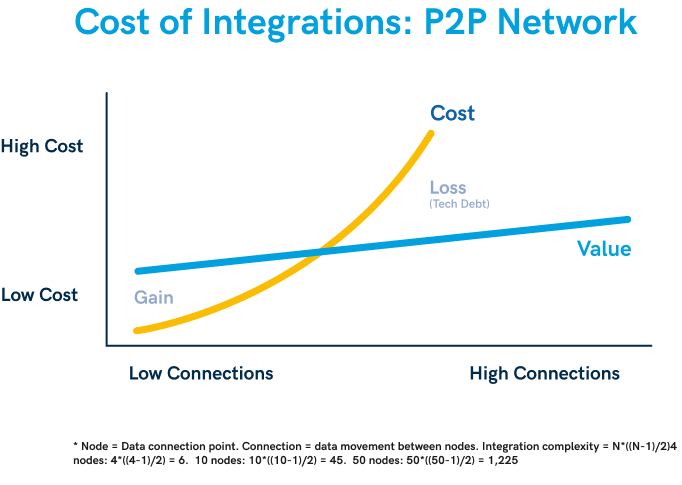4 Reasons to Use iPaaS for Data Integration
Executive Summary: Why should you consider using iPaaS for your Data Integration Needs? 1. You can stop the struggle of data integration 2. You can gain a competitive advantage 3. You can increase your efficiency through less connections 4. You can save money through less connections
Article
10 min read

Since you're reading this article about reasons to use iPaaS for data integration, it's probably safe to assume:
You're working with various business apps and multiple data nodes
You really need them to talk to each other better
You're not sure yet if iPaaS is the best way to make that possible
It's also safe to assume you're not looking for a lot of super technical or complex information at this point.
If that sounds like your situation, then you're in the right place.
Why?
Because we wrote this article to specifically help people like you get the answers you need to help your company decide which are the best data integration tools available to you today.
So we'll keep things easy to understand and to the point.
WHAT IS iPaaS?
Before we dive into the 4 reasons to use iPaaS for data integration, let's come up with a better answer to the question "What is iPaaS?".
Technically, iPaaS stands for Integration Platform as a Service.
Conversationally, iPaaS is a tech platform that a third-party company provides (usually through the cloud) to help you integrate and automate your apps and data.
Or, if you find analogies help you understand abstract concepts, try thinking of iPaaS like the United Nations:
The UN building is like the third-party iPaaS platform
The country reps are like your apps & data nodes
The language translators are like platform processes that enable your apps to talk to each other
The agenda is like platform rules and automation that get your data shared around and get your apps working together
But iPaaS is far better than the UN analogy because iPaaS also helps you create efficiency and scalability in a way that only digital technology can.
No surprise then that the global iPaaS market is growing so fast. In 2020, it was valued at $2.1 billion USD. By 2027, it's expected to reach $12.3 billion.

But let's bring this discussion down to the level of YOUR company and how iPaaS can help YOU.
First, are there really only 4 reasons to use iPaaS for data integration?
No. There are a lot more reasons than that. And we discuss those other reasons in other articles.
But for this article, we're only going to explore what we feel are the 4 most significant reasons to initially decide to use iPaaS for data integration.
These 4 reasons will likely give you what you need to decide if iPaaS makes sense for you and your organization.
From there, you can choose to explore all the other reasons why iPaaS is so powerful at getting your app, data and workflows integrated and automated.
Here we go.
REASON #1: YOU CAN STOP THE STRUGGLE OF DATA INTEGRATION
A recent market study found that about 89% of companies today are struggling with data and systems integration.

That means 89 out of 100 companies (and the people that work at those companies) experience stress over the following:
Getting different apps to talk and work together seamlessly
Protocol changes (either their own or ones controlled by a partner, client, app, etc.)
New apps added to the business mix
New data points needing to be acquired or reported on
Existing data points needing to be available to additional departments
Business workflow changes
New business workflows created
Why are 89% of companies struggling with those common everyday business demands?
Because that's what happens if you don't have a system in place that's designed to grow, adjust and scale as your company and your data needs change over time.
That's the struggle of data integration.
But what about the 11% of companies that aren't struggling? How do they respond when those things listed above inevitably show up in their work reality?
Well, they can let out a sigh of relief over having a data integration solution in place that's robust, scalable, and able to handle this latest need and whatever changes the future brings their way.
Are they necessarily using iPaaS?
Not necessarily. But iPaaS is specifically designed to put a stop to the struggle of data integration.
That's why a good iPaaS solution can be modified and expanded as your company needs along its life cycle without the process being a hassle or a stressful experience.
Benchmark Question: Can you imagine what it would feel like to be among the 11% of companies NOT struggling with data integration? If not, you need iPaaS.
REASON #2: YOU CAN GAIN A COMPETITIVE ADVANTAGE
Now, imagine you're among the 11% of companies that are NOT struggling with data and systems integration...because you're leveraging iPaaS.
That means iPaaS is enabling you to:
Spend less time on your backend systems and manual processes that create errors and drain profitability
Spend more time on your business processes, deliverables and sales
That translates into you having a serious competitive advantage.

Because the reality ALL businesses must face today involves more apps, more data, and getting it all to talk and work together well even as the protocols and data sets continue to change.
That business reality can either create an endless series of costly setbacks for your business, or it can be a driver that helps you gain ground on the competition...if you have the help of iPaaS.
Benchmark Question: Is your current data integration and automation approach a competitive advantage or a business liability?
REASON #3: YOU CAN INCREASE YOUR EFFICIENCY THROUGH LESS CONNECTIONS
One of our Fortune 500 clients – CRM giant Salesforce – was facing a data integration nightmare.
They had 54 data nodes and were headed toward building an unwieldy 1400 point-to-point connections.
Direct connections between data nodes are very inefficient, to say the least.
To get just a glimpse of what that would look like, check out the illustration below. This is what's called a point-to-point (P2P) network.

In a P2P network, all your process flows are direct between two nodes. There's no logic layer between the nodes. There's no intermediate transformation of data.
Direct connections between data nodes are very inefficient, to say the least.
But that's how many businesses try to tackle integrating and automating their data and apps. One dedicated connection at a time.
The alternative is how we do iPaaS at Launchpad: through a modern Enterprise Service Bus (ESB) architecture.
With an ESB model, you gain the advantage of having connectivity from any and all of your apps through a central intermediate ESB layer.
That's exactly how we helped our client. Instead of that spaghetti-like mess seen above, they ended up with something elegant and efficient like what's seen below.

With an ESB model, when any of your apps need access to a piece of data, you don't have to create (or recreate) another data connection. Instead, everything gets routed through your ESB layer.
That means you have less connections, which increases your efficiency.
Benchmark Question: Does your current data integration and automation approach increase your efficiency by enabling you to use less connections? If not, you need the power of an ESB-model iPaaS solution.
REASON #4: YOU CAN SAVE MONEY THROUGH LESS CONNECTIONS
We saw how iPaaS can increase your efficiency through needing less connections.
But having less connections also gives you the benefit of spending less money on development and operations.
The graph below illustrates the actual math behind the costly nature of more connections:

See the trajectory of the yellow line in the chart above?
That's what you want to avoid.
With the right kind of iPaaS solution, you can get ONE connector created that you simply reuse with any and all apps, both today and tomorrow, where that data is compatible.
That yellow line represents where companies are headed if they fall into the trap of creating direct connections between data nodes.
That one-to-one approach might seem easier and less costly at first. After all, as the chart above shows, if you only have 4 nodes, you only need 6 connectors to get them integrated.
But that yellow line is exponential, not linear. So even the small step up to 5 nodes means a big jump up to 10 connections.
And 10 nodes means 45 connections, 20 nodes means 190 connections, 50 nodes means 1225 connections, and so on, until your whole system quickly becomes overly complicated and expensive in terms of building and maintaining.
But with the right kind of iPaaS solution, you can get ONE connector created that you simply reuse with any and all apps, both today and tomorrow, where that data is compatible.
That reusability means you have a system with less connections, so it costs less to develop and maintain (not to mention being truly scalable going forward).
Benchmark Question: Does your current data integration approach result in more connections being created than are necessary? If so, you need the cost-saving benefit of an ESB-model iPaaS solution.
SUMMARY & NEXT STEPS
So, those are probably the 4 most significant reasons to use iPaaS for data integration:
You can stop the struggle of data integration
You can gain a competitive advantage
You can increase your efficiency through less connections
You can save money through less connections
As we mentioned, there are a lot more reasons than that to use iPaaS for data integration and automation. You can learn more through our other resources.
But when it comes to deciding if iPaaS will help you and your organization, these 4 reasons are likely enough.
Your next step is to find an iPaaS provider that gives you the proven expertise and timely support you need to go from setup to operation and the ongoing evolution of your data integration and automation solution.
That's what we do at Launchpad for our clients every day. We'd love to help.
Try Launchpad risk-free
Transforming your integrations is easier than you think. Get started quickly with us.
- ©Launchpad 2024
- Privacy Policy
- Support